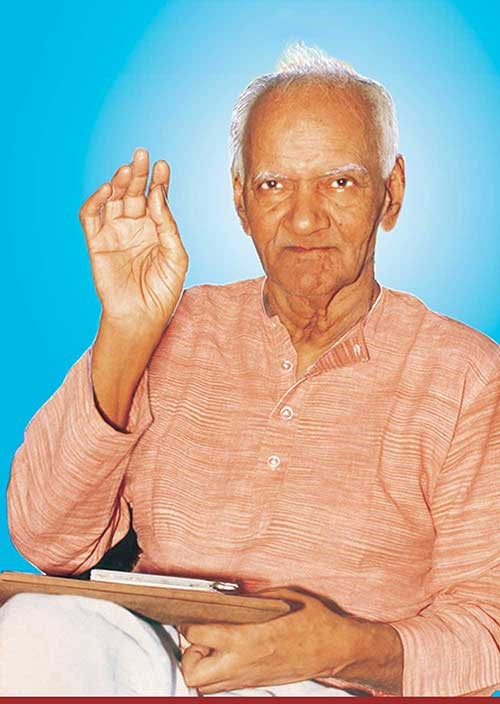Sūkṣmīkaraṇa Sādhana -15
Puruṣārtha – Virāṭ: The Effort Toward Supreme Consciousness
Establishing the Connection with the Universal Self
The essence of individual consciousness (Ātma-sattā) is the synthesis of sentient energy (chetanā-shakti) and material resources (padārtha-sampatti). In the same way, the all-encompassing cosmic existence is a combination of Prakṛti (Nature) and Brahmic Consciousness.
This subtle, invisible world (parokṣa-jagat) is a reflection of the Universal Being (Virāṭ Puruṣa). This reality was revealed by Rāma to Kauśalyā and Kakabhūṣaṇḍi, and by Kṛṣṇa to Yaśodā and Arjuna.
Within this vast universe, there is an infinite abundance of material and spiritual resources. All acts of creation, sustenance, and dissolution operate through the interrelationship between the individual (vyakti) and the collective (samiṣṭi).
The smallest atomic particles and quantum waves, combined with countless solar systems, form the Virāṭ Puruṣa’s gross body (sthūla śarīra). This represents the material realm.
Meanwhile, in the Creator’s subtle body (sūkṣma śarīra), the causal mechanisms of creation (kārya-kāraṇa sambandha), dynamic processes (kriyā-prakriyā), and events unfold.
The Role of the Subtle World in Universal Functions
- Sudden changes in creation
- Unexpected events
- The shape of the future
These are all governed by the subtle body of the cosmic intelligence. Only those with deep spiritual insight (sūkṣma-dṛṣṭi) can perceive this reality.
Just as an ordinary person remains unaware of their true self (ātma-sattā), so too does humanity fail to recognize the hidden dimensions of consciousness within nature.
The Inhabitants of the Subtle World
The subtle world (parokṣa jagat) is home to:
- Sublimated divine beings (sūkṣmī-kṛta divyātmās)
- Departed spirits (preta-ātmās)
- Ancestral souls (pitṛ-gaṇas)
- Microbial and viral lifeforms (viṣāṇu-jīvas)
It is an extraordinary world.
When an individual leaves their physical body, they remain in this realm until they take on a new birth. The movements between different realms (loka-lokāntara), experiences after death, and the mechanism of rebirth are all part of this unseen dimension.
Who can perceive this?
The Mahābhārata (Aśvamedha Parva) provides insight:
“Just as a person with eyesight can see fireflies flickering in the darkness, so too can enlightened sages (siddhas) perceive the movement of souls—how they leave their bodies, transition into new realms, and enter a new womb through their divine vision (divya cakṣuḥ).”
This “vision” is known as Darśana—the ability to see not with physical eyes, but through inner perception (sūkṣma netra).
Thus, the Vedic ṛṣis (sages) mastered this knowledge through yogic disciplines (tapas, titīkṣā). They gained direct insight into the workings of the universe, ensuring harmony in creation and imparting the secrets of spiritual evolution to humanity.
The Upaniṣadic Perspective: Unveiling the Truth
The Upaniṣads declare:
“Hiraṇmayena pātreṇa satyasya apihitaṁ mukham, tat tvaṁ pūṣann apāvṛṇu satyadharmāya dṛṣṭaye.”
(O Cosmic Nurturer! The face of Truth is concealed by a golden veil. Remove this covering so that I, a seeker of truth, may behold the Supreme Reality.)
This verse symbolizes the transition from material illusion to spiritual realization.
The aspiring seeker declares:
“O Virāṭ Puruṣa! Until now, I have been lost in the external beauty of the world. Now, through self-effort and spiritual discipline (puruṣārtha), I seek to behold the eternal, unchanging beauty of divine consciousness.”
This is the quest for spiritual unification with the Virāṭ Puruṣa, leading to the attainment of divine perception (sūkṣma dṛṣṭi).
The Structure and Dynamics of the Subtle World
Modern neurology states that sensory perception operates through neural impulses.
However, human eyes cannot perceive ultra-fine energy waves. Only through higher states of consciousness can one perceive these subtle dimensions.
Science once believed that the speed of light was the greatest velocity. However, new discoveries in quantum mechanics suggest the existence of even faster subatomic particles.
In his book “Relativity Revisited,” the author argues that:
“The speed of thought waves exceeds all physical velocities. It belongs to a dimension beyond sensory perception.”
Neurological studies confirm that:
- A nerve impulse takes 0.07 seconds to travel from the skin to the brain.
- But thought waves operate at infinitely greater speeds, beyond material measurement.
Spiritual Insights on the Speed of Consciousness
Ādi Śaṅkarācārya states:
“When the mind travels to distant realms like Brahmaloka, it discovers that pure consciousness (ātma chetanā) has already reached there before it.”
This reveals that the subtle consciousness surpasses even the speed of thought.
Astrophysicist Sir James Jeans echoes this wisdom:
“The soul dwells in an ocean of consciousness, where it interacts with the Supreme Reality through an uninterrupted exchange of energy.”
The great yogis use this very principle to expand their individual self into the cosmic form (Virāṭ Svarūpa).
The Scientific and Spiritual Connection
Modern scientists are gradually uncovering the structure of the subtle world.
- The ancient Vedic vision describes seven cosmic realms (saptaloka):
- Bhū-loka (Physical realm)
- Bhuvar-loka (Astral realm)
- Svar-loka (Mental realm)
- Mahar-loka (Buddhic realm)
- Jana-loka (Transcendental realm)
- Tapa-loka (Pure energy realm)
- Satya-loka (Realm of Ultimate Truth)
Each higher realm governs unique conscious entities with varying levels of embodiment.
- The lower realms are accessible to humans.
- The highest realms belong to divine beings (Mahātmās, ṛṣis, and siddhas).
The Need for Spiritual Evolution
Many departed souls (preta-ātmās) remain trapped in the subtle realm, unable to progress due to ignorance.
However, an advanced spiritual being (siddha) can establish contact with higher realms and channel divine energy into the material world.
This process is not about supernatural powers but about activating the soul’s hidden potential.
The Purpose of Sūkṣmīkaraṇa Sādhanā (Subtle Transformation Practice)
Today, humanity needs individuals who can bridge the material and spiritual dimensions.
- This is not about mysticism or miracles.
- It is about harnessing the latent powers within to bring higher wisdom, purity, and universal upliftment.
True transformation requires individuals who can:
- Refine their inner consciousness
- Expand their awareness to universal levels
- Serve as divine instruments of higher intelligence
This subtle transformation is my mission, and my sādhanā is entirely dedicated to this higher purpose.
Sūkṣmīkaraṇa Sādhana -15 Read More »

